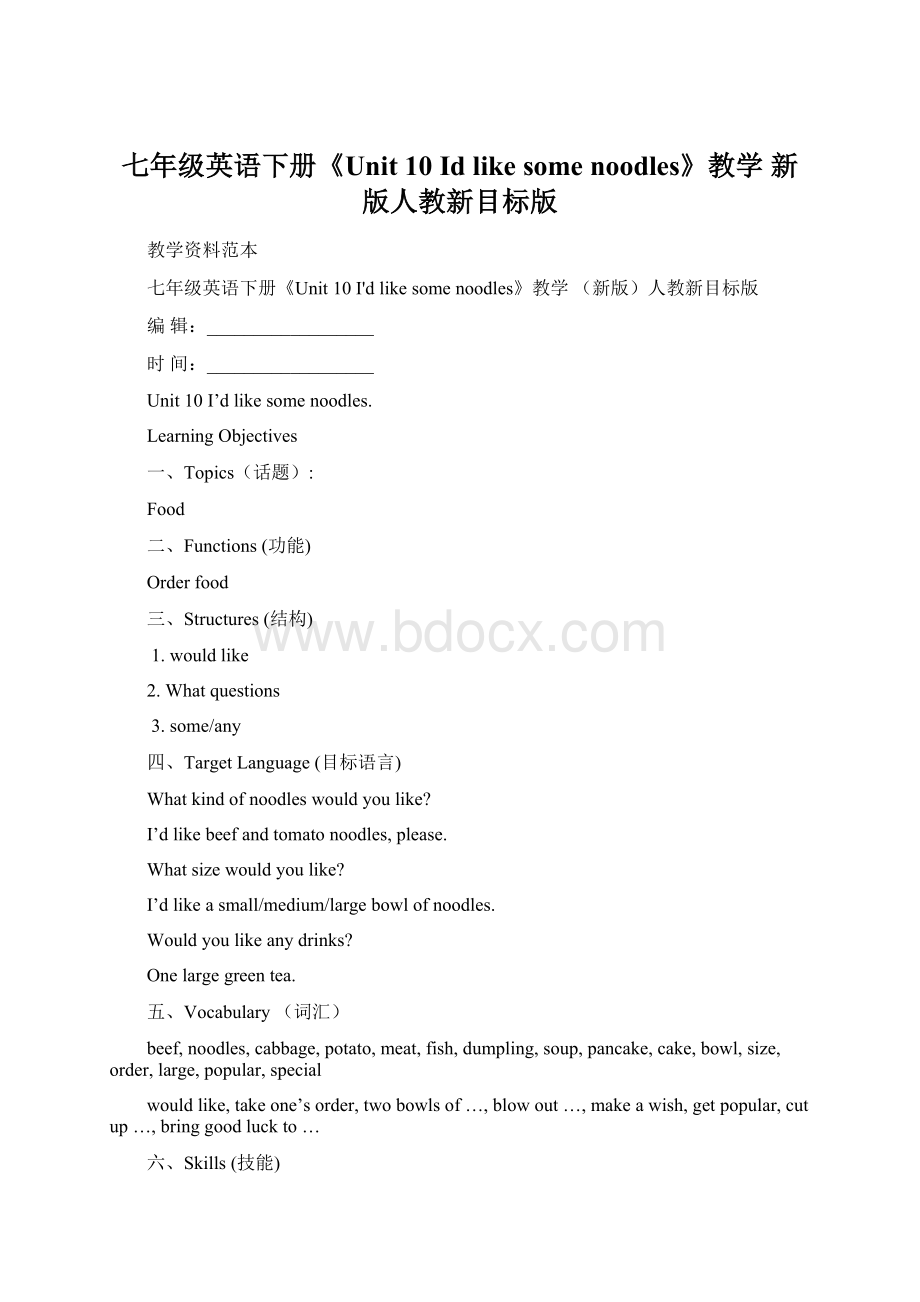七年级英语下册《Unit 10 Id like some noodles》教学 新版人教新目标版.docx
《七年级英语下册《Unit 10 Id like some noodles》教学 新版人教新目标版.docx》由会员分享,可在线阅读,更多相关《七年级英语下册《Unit 10 Id like some noodles》教学 新版人教新目标版.docx(13页珍藏版)》请在冰豆网上搜索。

七年级英语下册《Unit10Idlikesomenoodles》教学新版人教新目标版
教学资料范本
七年级英语下册《Unit10I'dlikesomenoodles》教学(新版)人教新目标版
编辑:
__________________
时间:
__________________
Unit10I’dlikesomenoodles.
LearningObjectives
一、Topics(话题):
Food
二、Functions(功能)
Orderfood
三、Structures(结构)
1.wouldlike
2.Whatquestions
3.some/any
四、TargetLanguage(目标语言)
Whatkindofnoodleswouldyoulike?
I’dlikebeefandtomatonoodles,please.
Whatsizewouldyoulike?
I’dlikeasmall/medium/largebowlofnoodles.
Wouldyoulikeanydrinks?
Onelargegreentea.
五、Vocabulary(词汇)
beef,noodles,cabbage,potato,meat,fish,dumpling,soup,pancake,cake,bowl,size,order,large,popular,special
wouldlike,takeone’sorder,twobowlsof…,blowout…,makeawish,getpopular,cutup…,bringgoodluckto…
六、Skills(技能)
Listeningforkeyinformation
Scanninginreading
七、Recycling(复习巩固)
Numbers1-9
Isthere…?
Arethere…?
Thebeefnoodlesarenotmine.
Theyarehers.
八、教材分析
本单元的话题是关于食物。
在这个单元中学生将学到很多关于食物的新单词,要求学生能够区分可数名词与不可数名词。
同时学生们将学习如何正确的点餐,了解不同地区的饮食差异。
SectionA学习关于食物的新单词,区别可数名词与不可数名词。
学会点餐的基本句型。
复习therebe句型。
1a,1b,1c主要是学习有关食物的名词,着重练习说,学习wouldyoulike句型。
复习therebe句型。
2a,2b,2c,2d巩固所学食物单词,着重练习听和写。
学会如何点餐。
GrammarFocus,3a,3b,3c主要是区别可数名词与不可数名词。
巩固练习点餐基本句型。
SectionB继续学习有关食物的单词,使学生学会表达自己的喜好。
学会填写订餐单,了解不同国家的饮食风俗,学会为餐馆写广告。
1a,1b,1c,1d,学习如何根据自己的喜好点餐,如何填写订餐单。
2a,2b,2c通过阅读短文使学生了解不同国家在过生日时的饮食特点。
3a,3b,3c学习如何为餐馆写广告。
SelfCheck对本单元知识进行检测和总结。
九、教学目标
1.通过本单元的学习,学生能用英语进行点餐,订餐,及为餐厅撰写广告。
了解不同国家的不同饮食文化。
2.通过本单元形容词的学习,学生既能够用正确的语言表达自己的喜好,也要具备基本交际能力。
十、教学重难点:
1.可数名词与不可数名词的区分。
2.点餐时的基本句型及交际运用。
十一、课时安排
第一课时:
完成SectionA1a–2c
第二课时:
完成SectionA2d–3c
第三课时:
完成SectionB1a–1d
第四课时:
完成SectionB2a–SelfCheck
TheFirstPeriod(SectionA,1a–2c)
Teachingaims(教学目标)
1.学会有关食物的新单词及点餐时所用到的新单词。
2.学会使用wouldyoulike去学问他人的喜好。
2.学会简单表
述自己的点餐内容。
。
3.复习therebe句型。
Languagepoints(语言点)
1.词汇:
1)名词n.noodle,mutton,beef,cabbage,potato,special,bowl,size,
2)形容词adj.large
3)动词v.would,wouldlike,order
4)副词adv.yet
2.句型:
Whatwouldyoulike?
Whatkindofnoodleswouldyoulike?
I’dlikebeefandtomatonoodles,please.
Whatsizewouldyoulike?
I’dlikeasmall/medium/largebowlofnoodles.
Difficulties(教学难点)
1.新单词的拼写,区分可数名词与不可数名词。
2.点餐的基本句型。
Teachingsteps(教学步骤)
1.Warm-upandrevision(课堂热身和复习)
(1)DailygreetingstotheSs.
(2)Revision(复习):
Reviewthenamesofsomefruitsandvegetables.
T:
Whatkindoffruitdoyoulike?
/Whatkindofvegetablesdoyoulike?
Ss:
Apples,bananas,oranges,pears,strawberries,tomatoes,carrots...
T:
Whatotherkindoffooddoyoulike?
Ss:
Milk,eggs,rice,chicken,burger,bread,ice-cream…
【教学设计说明】通过复习七上6单元内容,即谈论对食物的喜好,来导入新课。
这样设计既能帮助学生呈现知识网络
,又能自然导入新课。
简洁明了。
2.Presentation(呈现新知识)
(1)Presentthenewwords:
mutton,beef,noodles,chicken,carrot,potato,tomato.
T:
Doyouwanttoknowmyfavoritefoods?
Iwilldescribethem,andyouaretoguesswhattheyare.Ifyouknowtheanswer,pleasestandupandtelltheclasswhatitis.
(Showthepictureofdifferentfoods.)
Ss1.It’(羊).(mutton)
Ss2.It’(牛).(beef)
Ss3.It’(母鸡).(chicken)
Ss4.It’savegetable.It’sorangeandlong.(carrot)
Ss5.It’savegetable.It’sroundandcanbecutintopieces.(potato)
Ss6.It’snotonlyavegetable,butit’salsoakindoffruit.It’sredandround.(tomato)
(2)Workon1a.Matchthewordswiththefoods.ThencheckSs’answers.
(3)AsksomeSstoreadthenewwords.
【教学设计说明】本部分旨在要求学生认知新单词,图片教学法是呈现新知识最简单有效的方法之一,学生通过图片,能更价值观的理解新单词的含义。
3.Workon1b(完成1b)
(1)Listenandcheckthenoodlesthatthepersonorders.
(2)CheckSs’answers.
【教学设计说明】通过1b的练习,训练学生听懂新单词的能力。
4.Pairwork.
Workon1c.HaveSspracticetheconversationin1awithapartner.Thenaskthemtomaketheirownconversations.
GoaroundtheclassroomandhelpSswhennecessasry.
Havesomepairspresenttheirconversationstotheclass.Payattentiontotherebe.
(第一轮应提问成绩较好的学生,第二轮提问成绩较差的学生)
【教学设计说明】此环节为模仿操练,要求学生用所学therebe句型进行交际,主要渗透wouldlike的用法,并能熟练说出新单词。
在此环节的练习中应注意区分可数名词与不可数名词。
5.Workon2a&2b(完成2a和2b)
(1)T:
Pleaseturntopage56.Lookatthewordsin2a.Readthemaloud.
(2)T:
Nowlistencarefullyandcheckthenamesofthefoodyouhear.
(3)T:
Canyougettheanswers?
CheckSs’answers.
(4)T:
Pleaselookat2b.Listenagainand
(5)AsktwoSstopresenttheiranswerstotheclass.
(6)Readtheconversationfortheclasstochecktheiranswers.
【教学设计说明】此环节进一步巩固了本堂课所学的词汇和句型。
通过反复听读,可以让学生尽快熟悉生词。
学生填空,是检查学生能否听懂并拼写所学单词。
8.Pairwork
(1)Workon2c.HaveSsmakeconversationslikethis:
S1:
Whatkindofnoodleswouldyoulike?
S2:
I’dlikebeefnoodles,please.
S1:
Whatsizewouldyoulike?
S2:
I’dlikealargebowl.
Havesomepairstopresenttheirconversationstotheclass.Makesuretheychangethewordsused.
(2)T:
Let’splayapassinggame!
StudentAwillaskStudentBaboutthekindofnoodlesandsizethathe/shewilllike.StudentBwillthenaskanotherstudentaboutwhathe/shelikes,andsoon.
S1:
Whatkindofnoodleswouldyoulike?
S2:
I’dlikebeefnoodles.
S1:
Whatsizewouldyoulike?
S2.I’dlikeamediumbowl.(Turntothenextstudent)Whatkindofnoodleswouldyoulike?
S3:
I’dliketomatonoodles.
S2:
Whatsizewouldyoulike?
S3:
I’dlikeasmallbowlofnoodles.(Turntothenextstudent)Whatkindofnoodleswouldyoulike?
【教学设计说明】此环节既能充分练习学生的目标语言,使学生学以致用,同时也能尽可能给更多的学生开口说的机会。
此环节应让全班至少50%的同学参与进来。
10.Homework(课后作业)
Oral:
朗读并熟记第55页的单词和句子。
Written:
1.抄写第55页的单词和句子。
2.将所有学过的表示食物的名词按照可数
名词,不可数名词,既是可数名词又是不可数名词分为三类,写在笔记本上。
TheSecondPeriod(SectionA,2d–3d)
Teachingaims(教学目标)
1.能在日常情境中熟练在餐馆里点餐。
2.能用所学内容解决实际问题。
3.区别可数名词与不可数名词。
Languagepoints(语言点)
1.词汇:
1)名词n.tofu,meat
2.句型:
Whatwouldyoulike?
Whatkindofnoodleswouldyoulike?
I’dlikebeefandtomatonoodles,please.
Whatsizewouldyouli
ke?
I’dlikeasmall/medium/largebowl.
Difficulties(教学难点)
1.清楚地区别可数名词与不可数名词。
2.熟练掌握点餐句型。
Te
achingsteps(教学步骤)
1.Warm-upandrevision(课堂热身和复习)
(1)ShowSssomepicturesoffood.
(2)ShowpicturesofdifferentkindsofnoodlesandhaveSsnamethem.ShowSsthedifferencebetweenasmall/medium/largebowltoo.
【教学设计说明】通过谈论图片,既能复习之前单元所学内容,又可以自然过渡到下一个环节,并能帮助学生理解阅读内容。
2.Workon2d(完成2d)
(1)ThegirlinthepictureisSally,andtheboyisherfriend,Tom.Theyareinarestaurantorderingfood.ExplaintoSswhat“order”means.Role-playtheconversationin2d.
(2)Followtheexamplein2dandmakeupaconversationtoordersomefood.
(3)Readtheconversationandanswerthefollowingquestions.
Q1.Arethereanytomatoesinthebeefsoup?
Yes,thereare.
Q2.Howmanybowlsofbeefsoupdotheyneed?
One.
Q3.WhatelsedoesTomlike?
Helikesgongbaochickenandsomemapotofuwithrice.
【教学设计说明】学生通过回答问题能理解对话的内容,通过角色扮演能在情境中学会运用,通过自编对话能更好的让学生学以致用。
3.GrammarFocus
(1)Readthroughthesentences.
(2)AskSstofocusonthecountableanduncountablenouns.
【教学设计说明】本部分为本单元的内容核心,不仅概括了本单元的重点,还将基本句型一一呈现。
由于是总结性内容,故要求学生朗读。
可在课后将本部分列入听写内容。
此处可配合学生上一课时的课后作业,纠正学生错误,帮助学生归纳总结。
4.Workon3a(完成3a)
(1)3a.
(2)CheckSs’answers.
(3)HaveSsgetintopairsandrole-playtheconversationtofamiliarizet
hemselveswiththeorderingprocess.Askthemtochangethewordsused.
【教学设计说明】本部分旨在强化点餐句型,使学生关注点餐细节。
5.Workon3b(完成3b)
Writequestionsandanswersusingthewordsinbrackets.
【教学设计说明】巩固3a内容。
6.Workon3c(完成3d)
HaveSsgetintogroupsandmakeconversationsaboutthepicture.【教学设计说明】本环节要求学生能够活学活用,真正达到掌握目标语言的能力。
7.Homework(课后作业)
Getintogroupsandworkon3c
.Then,makeaconversationaboutorderingfood.
TheThirdPeriod(SectionB,1a–1d)
Teachingaims(教学目标)
1.继续学习有关食物的名词。
2.能熟练谈论自己喜爱的食物。
3.学会如何使用电话点餐,及如何填写订餐表格。
4.理解听力材料。
Languagepoints(语言点)
1.词汇:
1)名词n.dumpling,porridge,onion,fish,pancake.
2.句型:
Ilike…,…and….
Idon’tlike…or…
Difficulties(教学难点)
1.否定句中and换成or。
2.熟练掌握电话订餐。
Teachingsteps(教学步骤)
1.Warm-upandrevision(课堂热身和复习)
(1)CheckSs’homework.Asksomegroupstopresenttheirconversationstotheclass.
(2)AsksomeSswhytheywouldlike…(引导学生说出like)
【教学设计说明】1.复习了点餐句型和所学单词。
2.通过询问学生为什么要点某道菜,引导学生说出本课时的句型:
Ilike…and…
2.Presentation(呈现新知识)
(1)T:
Thereisgoingtobeaparty.Andwehavetopreparesomefoodanddrinksforit.Whatshouldweprepare?
Herearesomepictures.Pleasetellmewhattheyare.
(Showpicturesofthenewwords.)
1.It’satraditionalChinesefood,andweusuallyeatitduringtheSpringFestival.(dumpling)
2.Catsliketoeatthis.Itlivesunderwater.(fish)
3.It’sakindofdrinkandit’smadeoforange.
4.It’sakindofteaandit’spopularinChina.
Hereare
someotherfoods.Whatarethey?
(直接出示图片)HaveSsnamethefooditemsthattheyseeinthepicture.
(2)Workon1a.Matchthewordswiththepictures.
【教学设计说明】通过对每幅图片的描述,引导学生由使用旧知识过渡到自主使用新知识,达到了自然呈现的目的。
3.Pairwork
(1)Workon1b.Circlethethingsyoulikein1a.PutanXnexttothethingsyoudon’tlike.
(2)Tellyourpartnerwhatyoulikeanddon’tlike.
A:
Whatdoyoulikeinthepicture?
B:
Ilikedumplings,fishandorangejuice.
A:
Whatdon’tyoulike?
B:
Idon’tlikeonions,greenteaorporridge.
注:
and用于肯定句中,表并列关系,否定句中and要换成or。
【教学设计说明】通过对话练习使学生进一步掌握食物单词,以及and和or的基本用法,学会阐述自己喜欢的和不喜欢的。
4.Workon1cand1d
(2)Listenagain.Checkyouranswersin1c.
【教学设计说明】由于本环节学生需要填写的内容较多,因此建议学生连听两遍,完成表格。
听第三遍时在和学生一起核对答案,
5.Pairwork
(1)HaveSsgetintopairsandrole-playtheconversationin1c.
(2)Havesomepairsperformtheconversationtotheclass.
【教学设计说明】听力材料是最好的交际对话,因此可作为学生模仿的例文。
此环节帮助学生更好的理解听力内容,记住关键句型。
6.Homework
1.背诵1a单词,家长听写。
2.背诵听力材料,并仿照听力材料自己编写
一段对话。
TheFourthPeriod(SectionB,2a–SelfCheck)
Teachingaims(教学目标)
1.能够理解阅读文章。
2.能够通过阅读